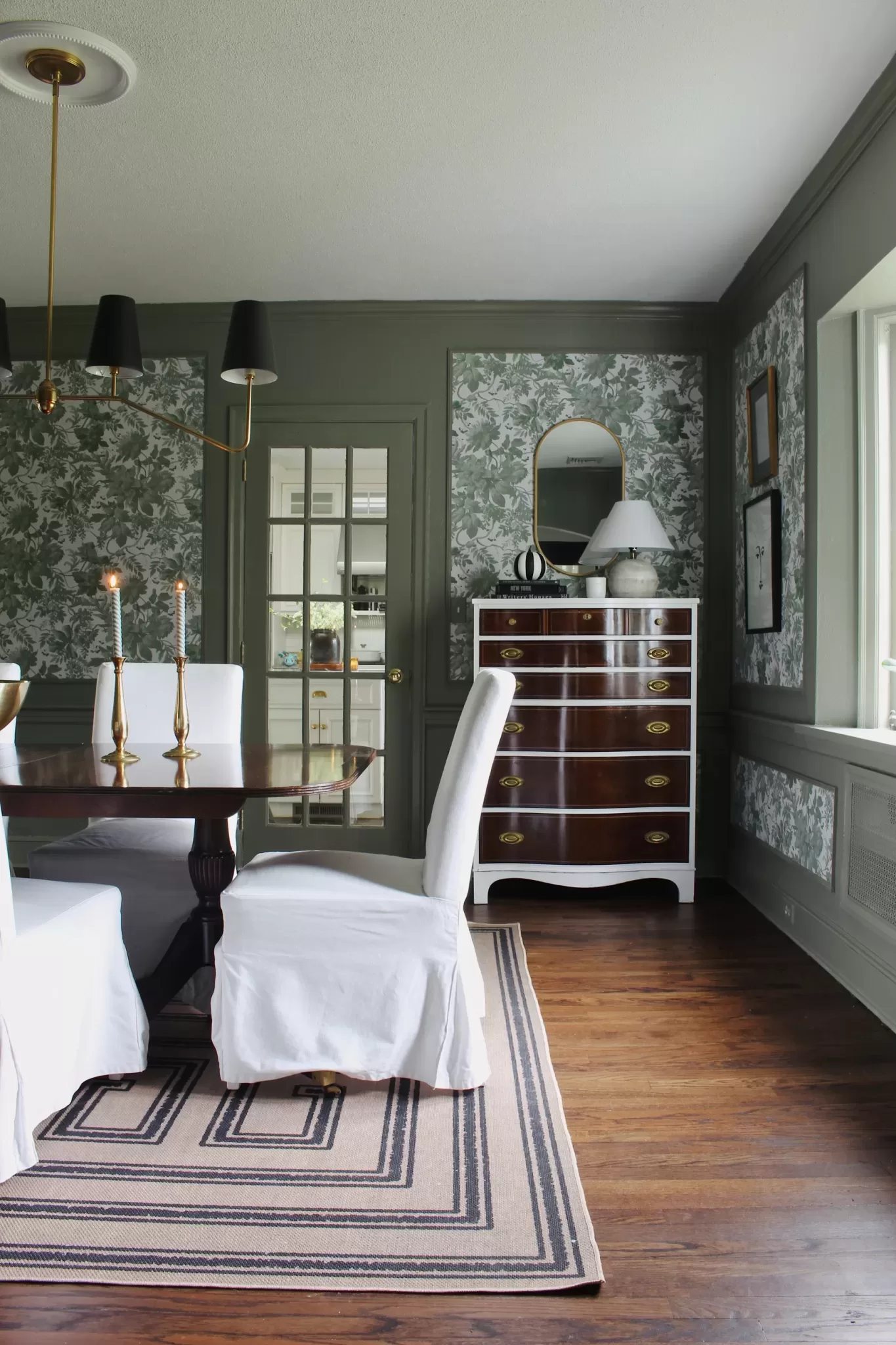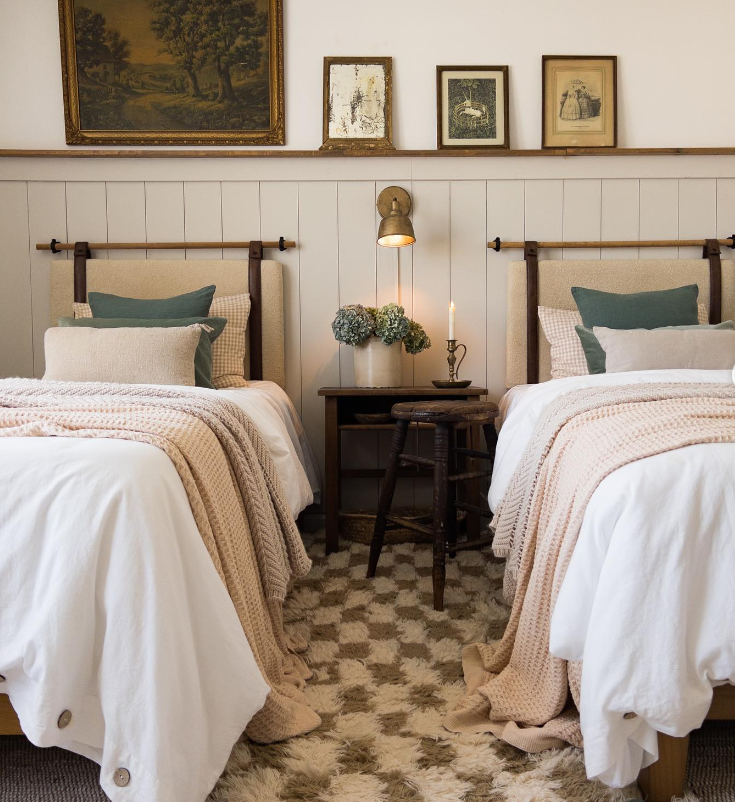The Top Paint Colors for Dark Rooms, Plus How to Choose One

If you’re currently on a quest to find the best paint colors for dark rooms in your home, and you’re feeling a little overwhelmed, I see you. There’s a lot to consider when selecting the right shade, since it’ll impact both the function and the aesthetic of the space. For example, do you want to embrace the limited light and create a moody, cozy space? Or are you trying to brighten things up and create a room that feels airier? There’s also lots of information, and misinformation, on choosing paint colors for dark spaces.
The key to making a decision you don’t regret as soon as the paint dries, is to understand a few things about how color behaves in dark rooms, as well as the room you’re painting.
After writing about paint colors for decorating magazines for more than 12 years, and choosing dozens of paint shades for my own homes and Airbnbs, I’ve got some hard-earned tips on picking paint colors for all sorts of spaces.
Here, I’ve put them into an extensive guide for choosing the best paint colors for dark rooms.
How to choose the best paint colors for dark rooms
From the colors to steer clear of, to how to solidify your decision, here’s and overview on how to choose the right paint shade for a dimly lit space, and tips for narrowing down your choices.
Tip 1: You don’t need to paint it bright white.
There’s a common misconception in decorating that dark rooms should be painted white in order to brighten them up and “make them feel bigger.” But this isn’t necessarily correct.
In fact, white and off-white paint colors can often fall flat in dark rooms.
To truly enjoy the beauty of white paint, it needs to be able to reflect light. If there’s not a lot of light to reflect, you can end up with a room that looks dingy or gray-toned. I was certain when we first moved into our house that I wanted to paint my low-light dining room with Sherwin Williams Aesthetic White for a creamy, bright look. But when I tried the swatch on my wall it looked gray-toned and sad. (I’ll share what color I went with instead in a minute!)

If you want to create a room that feels airy and open, but it doesn’t get a lot of natural light, white isn’t necessarily the best bet.
(The one caveat to this, in my experience, is if you’re painting a dark, windowless bathroom, and you’re trying to create a more functional space so you can see what you’re doing. In this case, white can be a good choice for functional reasons!).
Tip 2: Go for light colors over pure white.

Just because white paint colors can be hard to pull off in dark rooms, doesn’t mean you need to paint your room a dark color. In fact, you can actually achieve a similar look to white paint in a dark room … with a light paint color instead of a pure white one.
For an effect that’s similar to white, but better suited to a dark room, choose cream, pale beige or greige tones, like Sherwin Williams Creamy, Pacer White, or Navajo, or Benjamin Moore Pale Oak (Above) or Fossil.
All of these have enough color pigment to offset any shadowing, and will look like the palest neutral color instead of a dirty version of white.
The other thing about paint with more pigment is that it can hide more sins that white can. What I mean by that is, if the light in your room makes everything look gray, choosing a paint color with more warmth can balance that out.
Tip 3: Try a mid-tone color

When I realized that Aesthetic White wasn’t the right color choice for my dining room, I did a complete 180 and decided to paint the room a mid-tone gray blue instead.
Mid-tone paints are ones that aren’t too dark and aren’t too light. They make a room feel moody, without making it feel imposing or just plain dark. If you’re looking for a mid-tone paint color, go for an LRV, or light reflectance value, of 20-60. You’ll find most paint brands have paint color LRVs listed on their websites.
Mid tone paint colors are my favorite choice for dark rooms. They’re a happy medium, because dark colors, with an LRV under 15 or so, can feel too dark, like you need to turn all the lights on to see what you’re doing kind of dark.
Tip 4: You might need a cleaner color than you think.

One of the ways to describe paint colors is “clean” and “dirty.” Clean, or clear, colors are colors without a lot of gray in them, and are often the “truer” version of that color. Think colors you’d find in a Crayola 16 pack, or shades like robin’s egg blue, mint green, bubblegum pink, etc.. Dirty colors, on the other hand, have more gray or brown tones to them. They tend to look more subdued and elegant. These are hues like olive, sage, or dusty rose.
Most people choose slightly dirty colors for their home, unless they have a very preppy style or are painting kids spaces.
Where this can cause problems in darker rooms is that sometimes, the neutral colors in a dirty paint tone can overpower the color pigment, so you end up seeing more gray than blue in a blue-gray paint color, or more brown than green in an olive one. I suggest that when you go choose sample colors at the paint store, bring home a couple of swatches that look brighter or more colorful that you think you want. They may end up looking perfect in a dark room.
Now, that doesn’t mean you need a perfectly clean paint color in a dark room. I personally always choose colors with at least a little gray or brown in them. They tend to be more live-able. But, you just might need a little less dirty of a color.
I faced this, again, in my dining room. I thought I wanted a gray-blue before I decided on green, and I was certain one of my top choices would be Benjamin Moore Boothbay Gray. This was based on the fact that Julia Marcum from Chris Loves Julia had just used this color in her home office, and it looked like the perfect shade of gray-blue.
But, when I tried it in my dark dining room, it looked like a cool gray. I got almost no blue from it. So, I ended up choosing Benjamin Moore Wales Gray, instead. You can see below the difference in these colors, and how they looked in each of our spaces.



Tip 5: Test the color first
The biggest tip I have for choosing the best paint colors for low light rooms is to sample, sample, sample.
You can read all the guidance you can find around how certain colors react in certain lighting conditions, but the color will still look different in your home. The way a paint color looks will change based on the furniture and decor you have in your room, what kind of overhead lights and lamps you have, how your home is positioned, and even what’s outside the windows.
Colors will also looks very different in online photos that they will in your space. Ditto for how paint swatches look in the paint store.
I always suggest painting 12″ blocks of a color on all of the walls in a room and then looking at the color throughout the day. If your wall color is drastically different from the new one, painting a band of white primer around each color swatch can help you get a better read on the true color.
As far as specific colors for a low-light room, there are a few that I love which can give you a place to work from.
Best Paint Colors for Dark Rooms

Honestly, there are hundreds, even thousands of paint colors that would work well for a dark room. The one that’s exactly perfect will depend on your decor, the style of your home, and your hard finishes (the colors of your flooring, countertops, tile, etc).
However, to get you started, I’m sharing a few of the paint colors that I personally love for darker rooms.
1. Benjamin Moore Pale Oak

Pale Oak is a lovely greige shade that’s just a few shades deeper than off white. While Pale Oak is on the warm side, it’s warmth is neutralized in shadowy spaces, making it feel like a just-right neutral hue that’s not too cool or too warm.
2. Sherwin Williams Creamy

If you have your heart set on a white space, but off whites are making the room feel cold and flat, try Sherwin Williams Creamy. It’s a cream color (of course) with plenty of warmth, which appears subtle and soft in a dark room.
3. Sherwin Williams Fossil

This lovely bone color borders on beige, and is perfect for creating a creamy look with some depth in a low-light room.
4. Benjamin Moore Swiss Coffee

For an off white with enough depth to hold its own in a dark space, try Swiss Coffee. Its beige and yellow undertones make it feel bright and dynamic even in lower-light situations.
5. Farrow & Ball Treron

Farrow & Ball Treron is a beautiful gray-green that I think looks its most sophisticated in low-light rooms. In brighter spaces, it can look a little like a washed-out neutral green, but in dimmer rooms, it looks like an elegant and moody pewter color that’s not too dark.
Here’s another look at the shade in a darker space:

6. Benjamin Moore Wales Gray

I think Benjamin Moore Wales Gray is the ideal blue-gray for a low-light room. Too much light make this color look like a brighter blue, but low-light make it look calming and oh-so-sophisticated.
7. Sherwin Williams Red End Point

This was the SW color of the year in 2022, and I’ve loved it ever since. This is a great color for a dim room because it has lots of warmth and isn’t too light or too dark. It’ll help you embrace the low-light in your dark room while also making it feel inviting and ethereal. Plus, it’s bang on trend.
Also: Painting the ceiling the same color as your walls is a great look in low-right rooms if you want to embrace a moody vibe.
8. HGTV Home by Sherwin Williams Bracing Blue

HGTV Home by Sherwin Williams Bracing Blue is a mid-tone blue with periwinkle and gray undertones that looks downright ethereal in a low-light room. I chose Bracing Blue for my sons’ low-light bedroom, and it’s one of my favorite paint colors I’ve ever used.
Their room used to be painted Benjamin Moore Hale Navy, which is a very dark paint color, but it was just too dark for their space. The room has two small windows, one that faces north and one that faces west, and it doesn’t get much natural light during the day. It was literally hard to see in there sometimes. Bracing Blue gives their room life and sets a mood, but doesn’t feel overly dark.






